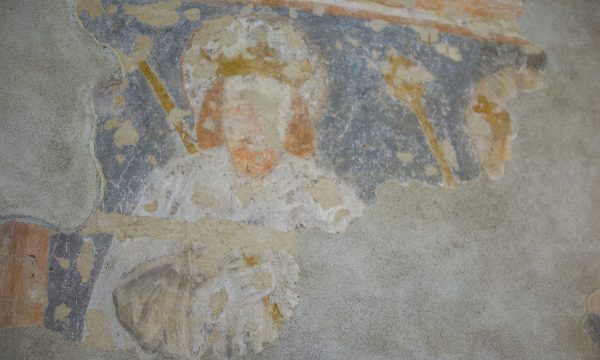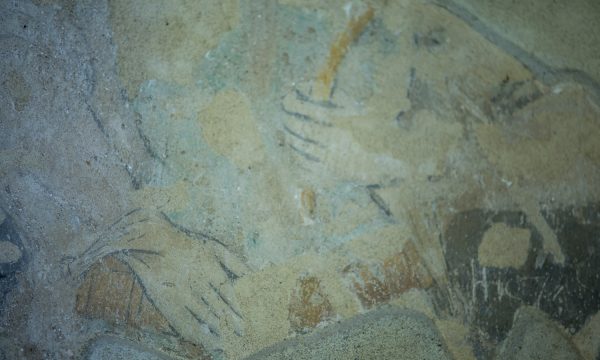Wall painting
The frescoes were discovered in 1995, when the church was renovated. The chancel arch was covered with paintings, which indicates that most probably the chancel was painted, too. A painting of a woman wearing a crown can be seen on the chancel arch`s right pillar. The features of her face are unclear, but her blue eyes and her lips can still be seen. Right across this fresco another woman saint was painted, but we cannot define who exactly, as her characteristics cannot be seen clearly.

On the right (south) side of the chancel arch three saint Hungarian kings were painted. Out of these three, the one depicting Saint Ladislaus is in the best condition. He can be identified based on his brown hair and beard, as well as his location. In the centre, the most important place we can see Stephen I, usually depicted with grey hair and beard. On the right side, Prince Saint Emeric can be seen; he can be recognized from his long hair and his beardless, young face. King Saint Stephen and Prince Saint Emeric are holding long maces, the latter probably also a lily, the symbol of his purity. The three kings were depicted together in other villages, too, like in Remete and Huszt.
On the left (north) side of the chancel arch we can see a Pietà picture. There is a painting of Virgin Mary holding her dead son in her laps flanked by two figures, possibly Saint John the Apostle and Joseph of Arimathea, who helped with the burial.

The woman saints were painted with a different technique than the kings and the Pietà, indicating that these pictures were not created at the same time. Based on their styles, the former might have been created at the end of the 14th century, while the other at the beginning of the 15th century.
Natural Heritage
Napkor village is located in the Middle Nyírség region of Hungary, on an alluvial plain covered by loess and loessy sand. Originally, most of the surrounding area was a waterlogged inter-dune mire, trapping groundwater and thus providing a marshy habitat for the local wildlife. Now only remnants of these habitats exist in the area, but they still hold a valuable fauna and flora.
Today, fens and bogs, lined by willows, poplar, and alder groves have replaced waterlogged areas. Due to frequent floodings, the marsh fern (Thelypteris palustris) grows in bulks in the marshy willows and alder marsh forests.
The most valuable species of the grazed, sometimes cut meadows is the Norwegian angelica (Angelica archangelica). An endangered ice age relict rare across Europe, it only grows in the Nyírség region in Hungary.
The males of the large copper (Lycaena dispar) butterfly can be easily recognized by their orange-red wings that are bordered by black lines. Its habitat is made up of fresh meadows and channels’ shores, the drainage of which could cause the species to completely disappear from the region. The southern festoon (Zerynthia polyxena) is still common, it can be seen on the edges of shrubs and abandoned fields. Its caterpillars eat the leaves of fruit trees in the genus Aristolochia.
The European ground squirrel (Spermophilus citellus) lives in the sandy or loessy short turf of the cultivated meadows and fields. It is widespread across the Nyírség region, its habitats are, however, in danger due to the decline of traditional animal husbandry. The ground squirrel’s underground network may meander several meters under the surface. It raises its offspring and rests during the winter in these tunnels. It consumes mainly seeds and plant matter, but will sometimes eat insects or the eggs or hatchlings of birds that nest on the ground.
The hoopoe (Upupa epops) favours the lightly vegetated ground of the cultivated fields spotted by groups of trees. It is notable for its distinctive ‘crown’ of feathers which are erected for a short time during landing. It nests in the cavities of old trees, in woodpecker’s holes.
